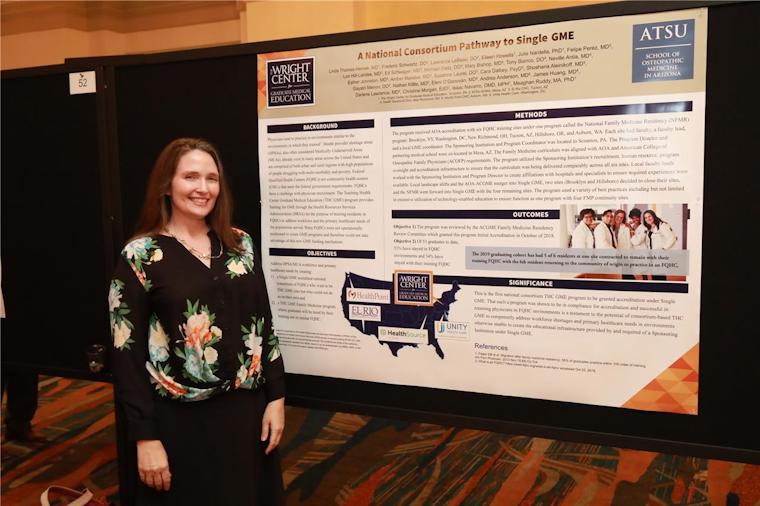Health provider shortage areas, comprised of urban and rural regions with high populations of people struggling with multi-morbidity and poverty, often have a challenge with physician recruitment. Dr. Meaghan Ruddy, vice president for Academic Affairs and director of Medical Education for The Wright Center for GME in Scranton, Pennsylvania, describes how a teaching health center family medicine program operationalized as a graduate medical education safety-net consortium. The program started with AOA approval and successfully earned ACGME Initial Accreditation in October 2018. Dr. Ruddy’s poster tells the story of that transition.
Poster: A National Consortium Pathway to Single GME
Author: Meaghan Ruddy, PhD, The Wright Center for GME
ACGME: Tell us about your academic and professional role.
Ruddy: I like to think I'm interdisciplinarity on legs, as my academic training is in philosophy, theology, and human development. I started teaching in undergraduate liberal arts in 2004 and eventually moved into undergraduate medical education in 2011. My doctoral dissertation focused on transformative learning theory in GME, which provided me the opportunity to transition from teaching medical students about human development and bioethics into GME with The Wright Center for GME working on faculty development and clinical learning program operations. I am currently the Director of Medical Education for the National Family Medicine Residency and Vice President, Academic Affairs for The Wright Center for GME. My current academic interests are in leadership development as well as organizational development and innovation.
ACGME: Can you briefly describe your project for us?
Ruddy: The project is our National Family Medicine Residency (NFMR), a teaching health center (THC) family medicine program that we have operationalized as a graduate medical education safety-net consortium or, as we like to call it, a GME-SNC. The NFMR is one family medicine residency program with four federally qualified health center family medicine practices (FMPs) in four separate regions across the United States: Auburn, Washington; Tucson, Arizona; New Richmond, Ohio; Washington, District of Columbia. The non-hospital, community-based Sponsoring Institution, The Wright Center for GME and the DIO are located in Scranton, Pennsylvania. The Sponsoring Institution provides funding for the employment of the program director, who is housed at the medical school educational partner, ATSU-SOMA in Mesa, Arizona. Program coordinators and faculty members exist at all FMP locations with oversight from a primary program coordinator located at the Sponsoring Institution. The program started with AOA approval, and has been working, since the first signals of the coming of [the transition to a] single GME [accreditation system], to ensure we were ready for the transition. The program successfully earned Initial Accreditation by the ACGME in October of 2018. This poster and our exhibit in the Exhibit Hall go into detail about challenges, victories, and lessons learned.
ACGME: What inspired you to do this project?
Ruddy: Communities in need are already feeling the impact of the primary care cliff and the inspirational vision of the architects of the THC GME program. The mission of training residents in underserved areas is too important to not do everything we can to ensure THC GME programs not only survive but thrive. We managed to make it happen, we want others to know it is possible and want to be a resource for any GME-related entity that is interested in learning more about how they can embrace a GME-SNC model for primary care expansion within their communities.
ACGME: What did you discover?
Ruddy: Start-up resources, inclusive of time, funding, and learning curve, were substantial. Organizational alignments and priorities tangential to the program caused two of the original six FMP sites to teach-out prior to the program's attaining ACGME accreditation. The ACGME accreditation process required several rounds of visits as the Review Committee [was] exacting in [its] approach given the uniqueness of this national GME SNC model. The four FMP sites that continued with the program began hiring their graduates and authenticated that the value of the investment outweighed the initial resource sink. As an example, the largest FMP site hired five of six of [its] PGY-3s. The sixth PGY-3 will be returning to [his/her] home region to work in an FQHC. To date, 54 percent of our graduates are continuing on in FQHC environments, 4 percent are continuing in other underserved environments, and overall retention in our own training FQHCs is 35 percent.
ACGME: What was the main takeaway?
Ruddy: The main takeaway for us is the value of the mission. Despite funding cuts and accreditation uncertainty, four highly-functioning FQHCs and the ACGME Review Committee for Family Medicine worked with the Sponsoring Institution, program leadership, faculty, staff, and residents to provide the means for this program to survive. All stakeholders were dedicated to the mission of workforce generation for communities in need and willing to innovate toward that end.
ACGME: Who could benefit from this?
Ruddy: Anyone curious about or seriously considering consortium models of residency, as well as mission-driven community organizations interested in increasing the number of physicians in their areas could benefit from learning more about this project.
ACGME: Any additional follow-up plans?
Ruddy: We are planning for our upcoming Continuing Accreditation visit and focusing intently on substantial compliance. We are also exploring the best ways to publish our work as it not only has ramifications for program innovation but also for GME funding, which is outside the scope of focus for this poster, but certainly a large part of our daily work. As we were accredited for more slots than we currently have filled, we are also talking with other FQHCs throughout the nation to determine fitness for expansion.

